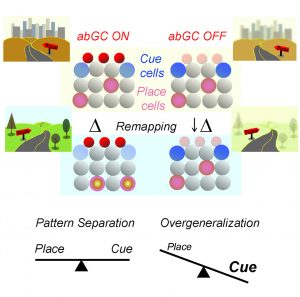A new study led by Drs. Tuncdemir and Grosmark recently published in Neuron is titled ‘Adult-born granule cells facilitate remapping of spatial and non-spatial representations in the dentate gyrus’. The hippocampus is brain structure central for several forms of memory including the episodic memories that let us keep track of what’s previously happened to us, and spatial memories which allow us to navigate around the world around us. One unique aspect of the hippocampal formation is the presence of the continuous birth of new neurons throughout one’s lifetime, a process known as adult neurogenesis. This adult neurogenesis is thought to help us encode new memories without interference from previously stored memories that share similar features. It does so by changing the importance of specific sensory events (cues or landmarks) when they are presented in different contexts through a process known as pattern separation. In the absence of neurogenesis – which could occur because of chronic stress or old age – cues or landmarks lose this contextual modulation and become dominant over the rest of the context. As a result, in psychiatric conditions such as PTSD, experiential features that would typically be neutral in most contexts, such as the sight of a plane or a high tower may evoke a strong memory of 9/11 and an intense emotional response – a process known as overgeneralization. The researchers for the first time describe in detail the circuit mechanisms by which deficits in remapping and pattern separation, observed in mice with reduced neurogenesis in the dentate gyrus, underlie the overgeneralization of negative memories that is often seen in PTSD or aging related cognitive impairments. Researchers are now using advanced imaging and manipulation strategies aimed at targeting this circuit in awake behaving mice models to decrease overgeneralization, with the potential for developing strategies useful in treating these disorders.
